Updating your plugins and themes regularly is necessary to keep your site running at full capacity. However, the fatal WordPress error “maximum execution time exceeded” can prevent updates and leave you feeling concerned about your website’s performance.
Fortunately, you can use a few methods to remove the error or increase the maximum execution time: You can uninstall the problem software, use a plugin, or edit your site’s code directly to solve the issue in no time.
In this article, we’ll look at what the WordPress maximum execution time error is and why it happens. Then we’ll walk you through six methods you can use to solve the problem and keep your site running smoothly:
- Uninstall problem software
- Use a plugin
- Adjust the wp-config.php file
- Update the php.ini file
- Edit the .htaccess file
- Contact your hosting provider
Let’s get started!
What the WordPress Max Execution Time Error Is (And Why It Happens)
The maximum execution time error is one of the most common WordPress errors. It can appear when you are trying to update your WordPress plugins or themes.
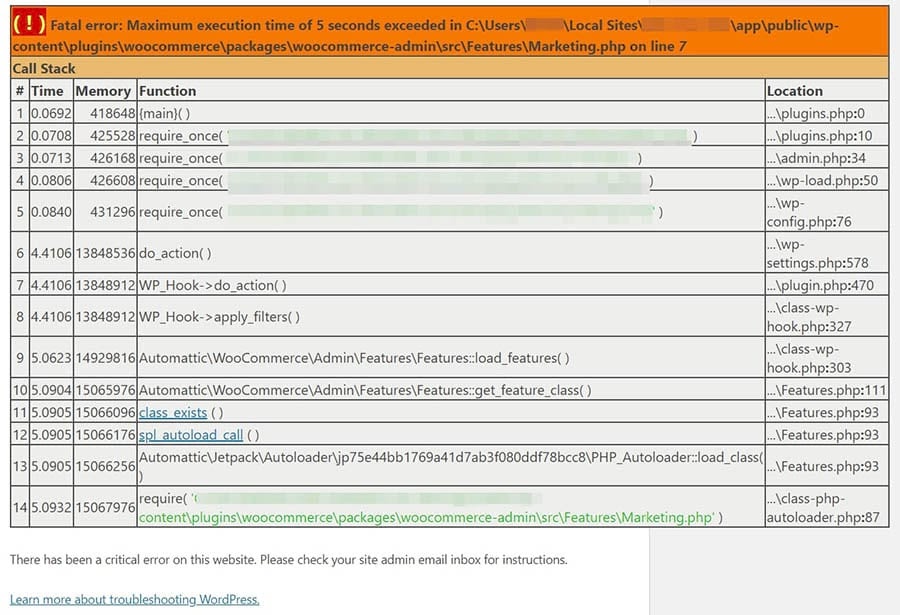
It alerts you that your site was unable to perform the updates you requested.
This error happens because of the PHP scripts on your website. PHP is a scripting language that is the foundation of WordPress sites. It is made up of code that controls how the website functions and shows different elements to users. As such, the maximum execution error directly relates to how long a PHP script takes to run.
PHP scripts have a maximum execution time to keep your site functional and secure. For example, if there were no limit, a hacker or malicious software could use neverending scripts to dismantle your website’s server and make your data vulnerable. Furthermore, PHP scripts running for a long time can divert resources from your server.
Plugins are more likely to trigger the error because they come with a lot of code from external sources. WordPress is an open-source platform, so any developer can design and upload plugins for it. If you install content from lesser-known developers, it may come with flawed code and cause issues in your site’s PHP scripts.
Themes and general WordPress updates can also cause the problem. However, this is less common.
What the Standard Max Execution Time Is
At DreamHost, we set the maximum execution time on our end. As with most other hosting providers, it usually has a duration of 30 seconds. This is typically enough time for most PHP scripts to run successfully. If you’re using a different hosting provider, you should be able to contact them directly to find out what your site’s maximum execution time is.
However, large websites with multiple resources may need slightly longer maximum execution times. Otherwise, they may not be able to complete their processes before the clock runs out.
Additionally, some developers may use very long execution times of more than 300 seconds. However, we don’t recommend this for most websites because of the security issues that we discussed previously.
How to Figure Out if the Error Has Occurred
It is usually obvious that the maximum execution time error has happened because you will see a notification in your WordPress dashboard.
But it may not always have the same wording. For example, it may read as “fatal error” or ‘critical error.” The notification also might not reference the maximum execution time. However, all of the warnings share similar components that can alert you to the source of the problem.
Front-end users may also be able to see the error. If they visit the site when the update process has failed, they might see a message telling them that your website is experiencing technical difficulties.

However, this error message doesn’t only appear because your maximum execution time has been exceeded. As such, you’ll want to check and see if it shows up in your WordPress dashboard as well.
Finally, you may receive an email from WordPress alerting you that the maximum execution time has been exceeded. This happens because of the WordPress 5.2 update, which introduced PHP error protection that automatically notifies you when your site has problems with its themes or plugins. As such, you will almost immediately know that there is an issue with your updates.
Skip the Stress
Avoid troubleshooting when you sign up for DreamPress. Our friendly WordPress experts are available 24/7 to help solve website problems — big or small.

How to Fix the Max Execution Time WordPress Error (6 Methods)
There are a few different methods you can use to eliminate the max execution time error or increase your site’s maximum execution time.
You may first want to consider your comfort level with directly editing your site’s files and adding new code. If this method sounds beyond your technical abilities, there are fortunately other options available.
1. Uninstall the Problem Software
One of the simplest ways to fix the maximum execution time error is to uninstall the software causing the issue. One of your plugins or your site’s theme is likely the culprit, so you can start there.
We recommend using this method if you have a hunch that a specific application is causing the problem. For example, you may have recently added a new plugin or updated an old one.
If the error locks you out of your site, you can access the dashboard via Recovery Mode. If you received an email from WordPress about the failed updates, it usually includes a link to Recovery Mode and may even tell you which plugin caused the problem.
Then, navigate to Plugins > Installed Plugins and click on Deactivate underneath the relevant item. Click on Delete to remove it.
If you don’t know what is causing the maximum execution time exceeded error, you can deactivate all of your plugins and reactivate them one by one. Refresh each time and see if you can find the one that triggered the problem.
You can use Secure File Transfer Protocol (SFTP) to remove the plugin. Alternatively, if you have a fully hosted DreamHost account, you can do it with your control panel file manager.
Navigate to Websites > Manage Websites, and hover over the preview above your domain name. Then click on Manage.
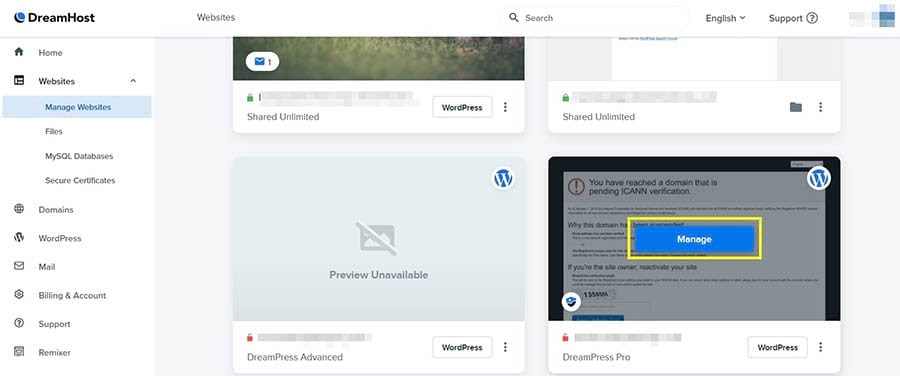
Scroll down and select Manage Files.
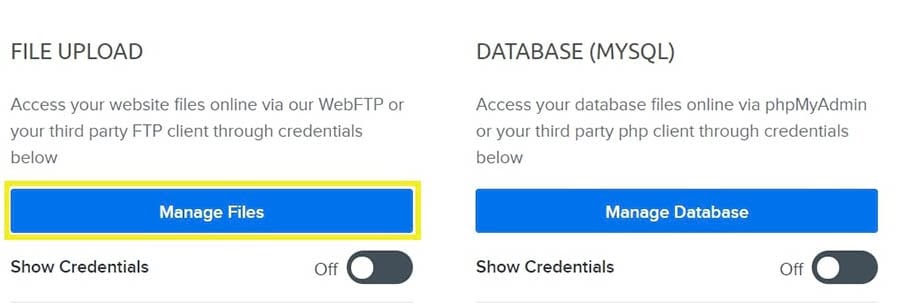
Then navigate to your website’s directory folder. Enter the Plugins folder, right-click on the plugin you want to remove, and select Delete.
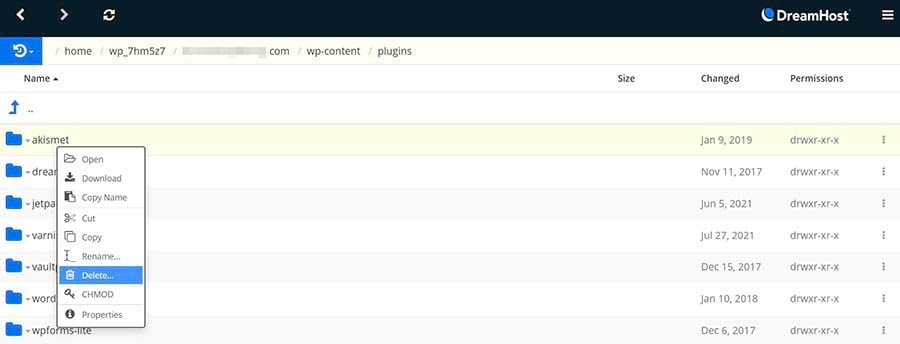
Hopefully, this will resolve the error. If not, you can move on to the following methods.
2. Use the WP Maximum Execution Time Exceeded Plugin
One of the easiest ways to increase the maximum execution time is by using the WP Maximum Execution Time Exceeded plugin.
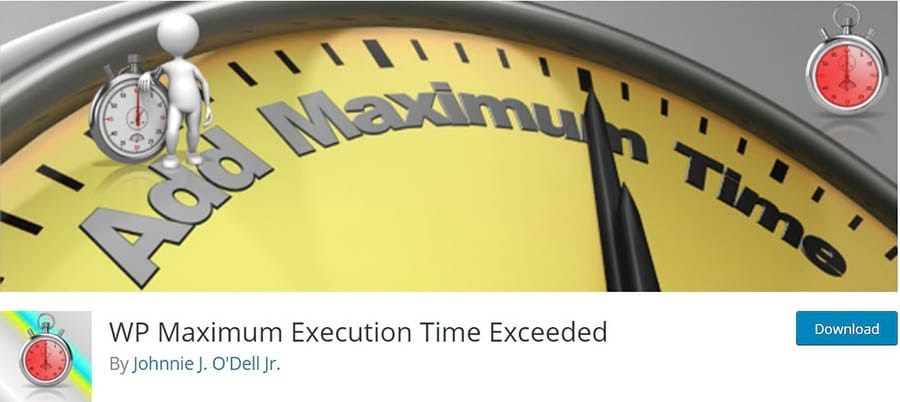
This tool enables you to increase the maximum execution time to 300 seconds (five minutes) while you have it activated.
You may prefer to use this instead of the previous method because it can increase your maximum execution time globally. This can be beneficial if you want to give functional plugins and themes a little more time to complete their updates.
To use the plugin, you can download the .zip file and head to your WordPress dashboard. Navigate to Plugins > Add New and click on Upload File > Choose File.

Click on Install Now. Once the plugin is installed, select Activate Plugin to complete the process.
The plugin automatically increases your site’s maximum execution time right away, so you don’t need to do anything else. If you ever want to remove it and revert to the original settings, you can head to Plugins > Installed Plugins and click on Deactivate.
This is a straightforward fix for the maximum execution time exceeded error. However, it does not enable you to choose a custom duration. If that’s something you’re looking for, you may prefer to use one of the following more intensive methods.
Related: How to Pick the Right WordPress Theme for Your Website
3. Increase the Maximum Execution Time via wp-config.php
You can increase the maximum execution time in your site’s wp.config.php file. This is a core file that contains a lot of important information about your site. For example, it has your website’s name, host name, login username, and password.
We recommend this method if you want to customize your maximum execution time. It enables you to add code directly into your WordPress directory file. Furthermore, it’s relatively quick and easy to do.
Before you start editing the file, we recommend backing up your entire WordPress site. The wp-config.php file is essential for your website, so you don’t want to make a critical and irreversible mistake. With a backup on file, you can revert to your original settings with minimal effort.
You can find the file by using the DreamPress file manager or your SFTP application and looking for wp-config.php. Right-click on it and select Edit.

Alternatively, you can click on Download and edit the file with a simple text editor like Notepad. Once you’re in the wp-config.php file, scroll to the bottom and insert the following code:
set_time_limit(X);
“X” represents the maximum execution time in seconds. For example, you can replace it with “300”, and it will extend the duration to five minutes.
Now you can save the file, and you’ve successfully changed the maximum execution time!
4. Increase the Maximum Execution Time in php.ini
You can also increase the maximum execution time by creating a new php.ini file. This is a document that controls your PHP settings, such as resource limits, upload sizes, and file timeouts.
This method can be an excellent option if you use a Content Management System (CMS) like WordPress. php.ini affects all the scripts in your system, so you won’t have to edit each one individually.
Not all servers support php.ini files, so you’ll need to check first to make sure yours does. Then you can increase the PHP execution time with this method.
In the DreamHost server, php.ini files are called phprc. First, you’ll need to create a new phprc file. Go to your SFTP dashboard and navigate to your user directory.
Locate the phprc file in your site’s version of PHP. Then right-click on it and select View/Edit to add your new code. You may see this warning.
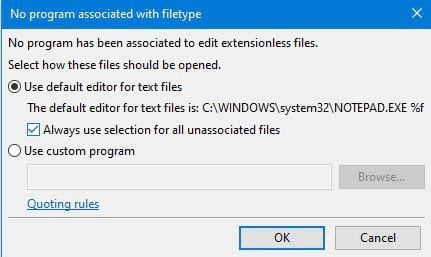
Click on the check box next to Always use selection for all unassociated files and select OK. This will open the file with your text editor. Next, you can enter the following code to change the maximum execution time:
max_execution_time = 500
This will change the max execution time to 500 seconds. Then you need to kill the existing PHP processes to update the phprc file and make the changes take effect.
5. Increase the Maximum Execution Time in .htaccess
The .htaccess file is another place where you can adjust the maximum execution time. This file controls changes across the different directories of your WordPress site. However, not all servers use it, and it is most commonly found in Apache servers.
You may prefer to use this method if you don’t want to play around with the wp-config.php file and if your server doesn’t support php.ini files.
Before starting, we recommend backing up your .htaccess file. By doing so, you can reinstate it if you make any major mistakes. Simply make a copy of it and save it elsewhere on your computer.
Then use your chosen SFTP to edit the original .htaccess file. If you’re using the DreamHost file manager, you can right-click on it and select Edit.
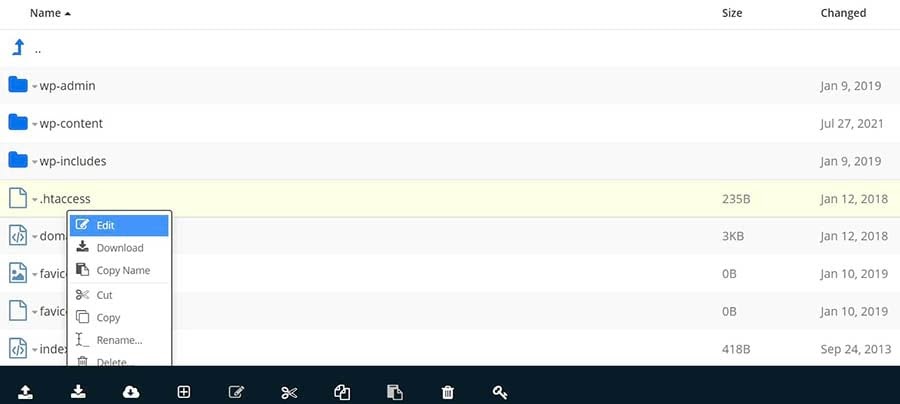
Otherwise, you can open it with your text editor. Then enter this code to change the maximum execution time:
php_value max_execution_time 300
You can substitute the “300” for any other amount you prefer. Finally, save the changes, and the file will apply them to your site.
6. Contact Your Hosting Provider to Request an Increase in Maximum Execution Time
If you would prefer not to change your site’s files yourself, you have another option. You can contact your hosting provider directly, and they can increase the maximum execution time on your behalf.
This method could be an excellent option if you’re short on time or have limited technical skills. However, it may cost extra depending on your hosting provider.
With a DreamHost account, you can contact our Professional Services team to make these changes for you. Navigate to the Contact Support page in your account dashboard and submit a ticket.
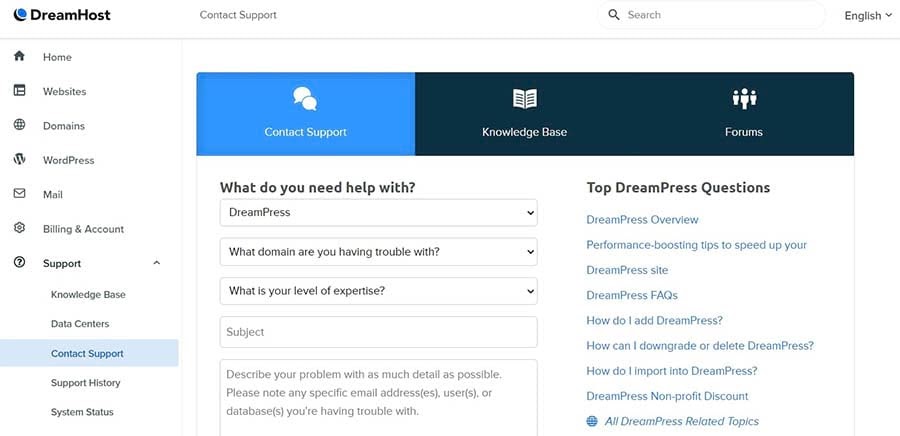
There, you can outline your desired changes and add any details about your site. Our team may ask for more details, and then we’ll get to work on making the changes!
Bonus WordPress Error Articles
Need to resolve other technical issues on your website? We’ve got you covered! Our team has put together several guides to help you troubleshoot the most common WordPress errors:
- How to Troubleshoot the WordPress White Screen of Death
- How to Fix the 500 Internal Server Error in WordPress
- How to Fix Syntax Errors in WordPress
- How to Fix the WordPress Not Sending Email Issue
- How to Fix the Error Establishing a Database Connection
- How to Fix WordPress Error 404 Not Found
- How to Fix White Text and Missing Buttons in WordPress Visual Editor
- How to Fix the Sidebar Below Content Error in WordPress
- What to Do When You’re Locked Out of the WordPress Admin Area
And if you’d like a soup-to-nuts walkthrough on running a successful WordPress site, be sure to check out our WordPress Tutorials. It’s a collection of 42 guides written by our WordPress experts that’ll help you navigate the WordPress dashboard like a pro.
Take Your WordPress Website to the Next Level
Whether you need help navigating the WordPress dashboard, fixing incorrect database credentials, or choosing a web host, we can help! Subscribe to our monthly digest so you never miss an article.

Fixing the Fatal Error: Maximum Execution Time Exceeded
The maximum execution time exceeded error in WordPress can get in the way of updating your plugins and themes. Although it can be frustrating when it happens, there are several ways to solve the problem quickly.
You can fix the maximum execution time WordPress error with the following strategies:
- Uninstall the problem item.
- Increase the maximum execution time with a plugin like WP Maximum Execution Time Exceeded.
- Adjust the maximum execution time by editing the wp-config.php file.
- Increase the maximum execution time in the php.ini file.
- Edit the .htaccess file to increase the maximum execution time.
- Contact your hosting provider to change the file on your behalf.
Are you looking for a hosting provider that can take care of all your site’s technical issues? Check out our DreamPress packages and leave the troubleshooting to the experts!
Image credit: Wikimedia Commons.
The post How to Fix Fatal Error: Maximum Execution Time Exceeded in WordPress (6 Methods) appeared first on Website Guides, Tips & Knowledge.
source https://www.dreamhost.com/blog/fix-wordpress-fatal-error-maximum-execution-time-exceeded/

No comments:
Post a Comment